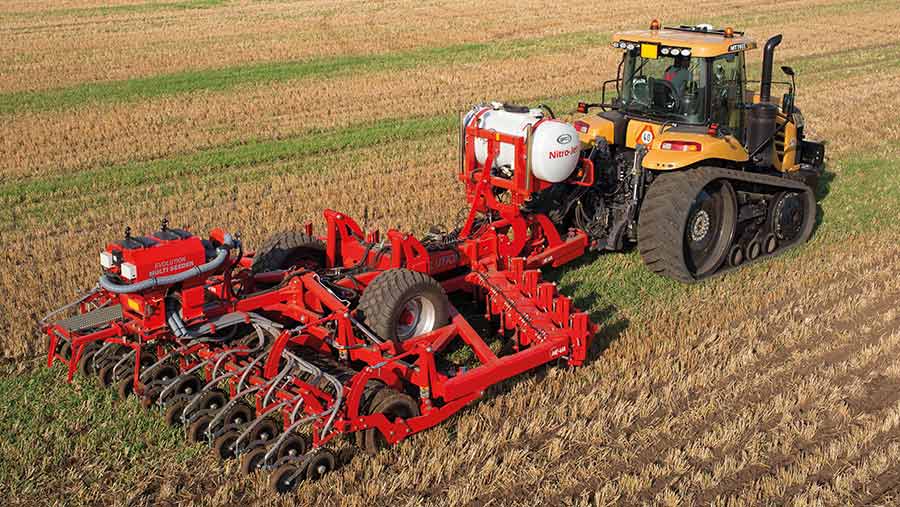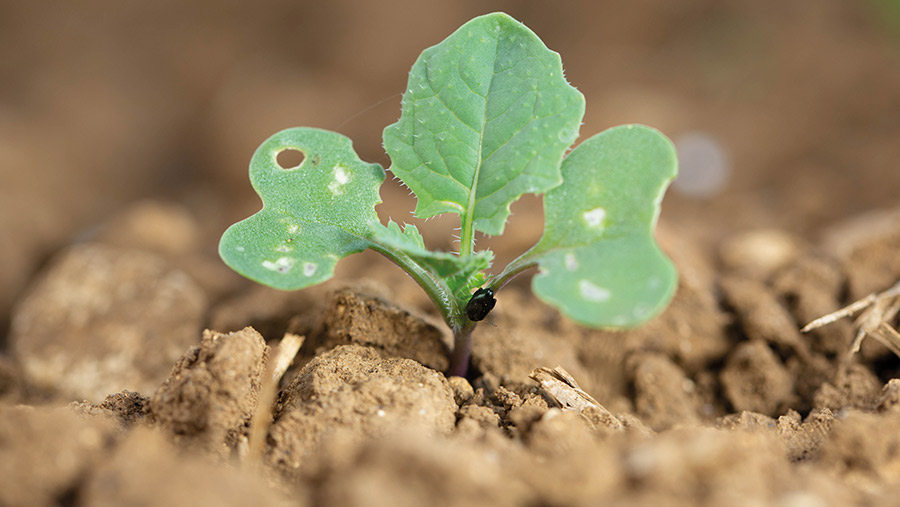8 tips on early OSR drilling to beat the flea beetle threat
 © Agrii
© Agrii More farmers are moving to early oilseed rape drilling on the back of growing evidence showing that it can help crops survive adult cabbage stem flea beetle attacks in late summer.
See also: How the new Arable Soils Standard could help fill the BPS gap
However, experts warn that there are also challenges when drilling OSR in late July and the first half of August that will need to be managed.
The first is having more plant growth available to support flea beetle feeding and egg laying, which will mean greater spring pressure from the highly damaging larvae.
Lizzie Carr-Archer, Dekalb campaign manager, also points to the higher risk of light leaf spot, club root and turnip yellows virus arising from crops being in the ground for longer in the summer.
Early drilling also brings the risk of lush, forward growth, which will have to be managed to avoid premature flowering and lodging. Lodging is especially a risk if drilled at high seed rates.
Finally, independent cultivations expert Philip Wright points to the challenge of timing, with a smaller window to cultivate and drill the crop at a busy time.
To help farmers overcome these challenges, Bayer and Opico have pulled together some practical pointers in a specialist guide. Here are some of their key tips:
1. Cultivation and drilling
Glenn Bootman, Opico cultivations specialist, says there are two key ways to establish OSR early. First, growers can direct-drill crops – for example, with a Sky drill – in fields where soil is in good condition and does not require any remedial work. But land in poorer condition that is “a bit tight” will need a tine running through, he says.
A subsoiler with narrow legs and appropriately winged points that lift and stretch rather than “boil” the soil should be employed for good vertical fracturing with minimal surface movement. In the past, growers simply subsoiled with a seeder spreading seed on the surface, but they typically achieved only 80% germination.
Instead, he advises using a subsoiler seeder with true coulters such as the Evolution. “This means you can get an even depth and seeds will germinate at the same time,” he says.
“If moisture is there, you are putting it in the moisture rather than on top of a dry surface,” he adds.
The single-pass system also has the ability to put slug pellets and liquid fertiliser (diammonium phosphate) near the seed.
2. Slug pellets and nutrition
The first six weeks are critical, as once the plant gets a good taproot, it will look after itself, says Mrs Carr-Archer. “OSR is a very resilient crop if it gets a well-developed taproot.”
To get a good taproot before the winter, the crop needs to keep going once it has germinated. Therefore, avoid any growth checks arising from nutrient uptake or slug attacks. Adding fertiliser and slug pellets can help avoid this.
Mr Bootman believes fertiliser should be placed with the seed rather than blanket-spread before or after drilling, putting it where it is needed.
3. Moisture
One key message from the 2019 drilling season was to only drill if there is moisture present. If it’s too dry, germination will be protracted, leaving plants more vulnerable to attack by flea beetle.
Mr Wright agrees about the need for sufficient moisture. “Otherwise don’t even think about drilling. Preserving moisture is critical, as is fine, well-firmed soil in the immediate vicinity of the seed, and effective consolidation for the best seed-to-soil contact.”
Mr Bootman advises drilling at 2-3cm. “If moisture is at 3cm, not 2cm, then go a little deeper to where the moisture is.”
4. Seed rate
The aim is to establish a population of 40 plants/sq m. However, establishment rates are higher when drilling early, so it’s important to avoid seed rates that will lead to greater populations.
5. Straw management
Because of the tight window, Mr Wright says there is unlikely to be enough time ahead of drilling for straw to be baled and removed – with the possible exception of winter barley. “So it needs to be thoroughly chopped and evenly spread.”
6. Variety choice

© Flea beetle on a young OSR plant © Tim Scrivener
Choosing the right variety is essential with early drilling, says Mrs Carr-Archer. Otherwise there is a risk of crops getting too forward and flowering prematurely before Christmas.
Farmers are looking for vigorous varieties to get them away from the summer flea beetle threat, and hybrids do demonstrate that vigour. Consequently, farmers are turning to hybrids to help manage the flea beetle risk, but care is needed to avoid excessive autumn development.
Hybrids have traditionally been used for drilling at the end of August/September, but sowing them in early August brings the risk of crops running away and, in some situations, stem elongation and flowering before Christmas. So it’s important to use varieties that are not over-rapid in their autumn development.
Stem stiffness is also important to minimise lodging. Therefore, growers should be looking for a variety with good stem stiffness along with vigour, with, ideally, a compact canopy with a lot of root matter.
Mrs Carr-Archer says the aim is to achieve a bushy plant going into Christmas and avoid stem elongation before then. Then, in spring, you want a plant to get up and go to move from any larval damage before they can eat the growing point. Farmers need vigour in the autumn and then again in the spring.
Disease resistance is also key. For example, light leaf spot pressure is elevated as the plant is in the ground longer, so it increases the risk of spores landing on the surface. This is why good light leaf spot resistance is essential.
With early drilling, Mrs Carr-Archer advises going for a light leaf spot score of 7 or above. “A 6 is good, but you want the best for early drilling.” For stem stiffness, go for at least a score of 8 for standing power. Verticillium wilt resistance is also useful.
Turnip yellows resistance also adds to the package, although she adds that growers should avoid sacrificing light leaf spot resistance or standing power.
Looking at all the required traits, she believes varieties such as Exstar and turnip yellows virus-resistant Excited and Expectation are ideal hybrids for early drilling. Exstar, for instance, has an 8 for stem stiffness, a 9 for lodging and an 8 for light leaf spot.
Conversely, varieties such as Exsteel and Expedient are better suited to traditional later August and September sowing slots to avoid crops getting too forward when drilled early.
7. Forward crops
Drilling early means crops will be further forward. An early autumn application of metconazole may be needed to regulate the growth of crops that are particularly forward, especially if they are also thick.
Relatively large canopies coming out of the spring will put the onus on careful spring nitrogen fertiliser management and effective plant-growth regulation.
8 Disease management
The reduced threat from phoma with early drilling gives farmers more flexibility to delay autumn fungicide treatments, targeting the higher light leaf spot risk more effectively.
Timely treatment of light leaf spot is key and the free Adas/Bayer SpotCheck service in the autumn is useful to help farmers identify infections before they become visible.
National Cabbage Stem Flea Beetle Management study
Sowing OSR in the first two weeks of August has helped many crops survive cabbage stem flea beetle.
Scientific evidence and practical experience over the past two seasons show the value of getting crops securely beyond their most vulnerable cotyledon stage before the peak of the flea beetle migration.
This was shown in the latest National Cabbage Stem Flea Beetle Management Study, carried out by Bayer, Adas and Niab, which showed noticeably better crop survival to harvest when drilling early than in the traditional late-August/early September slot. This trend was also seen in the more challenging 2019-20 season.
“Providing there is sufficient moisture, our own substantial grower surveys have consistently shown early drilling enables crops to tolerate levels of flea beetle grazing that might otherwise devastate them,” says Niab break crop specialist Colin Peters.
The Early OSR Drilling guide is available to download from both the Bayer and Opico websites.

